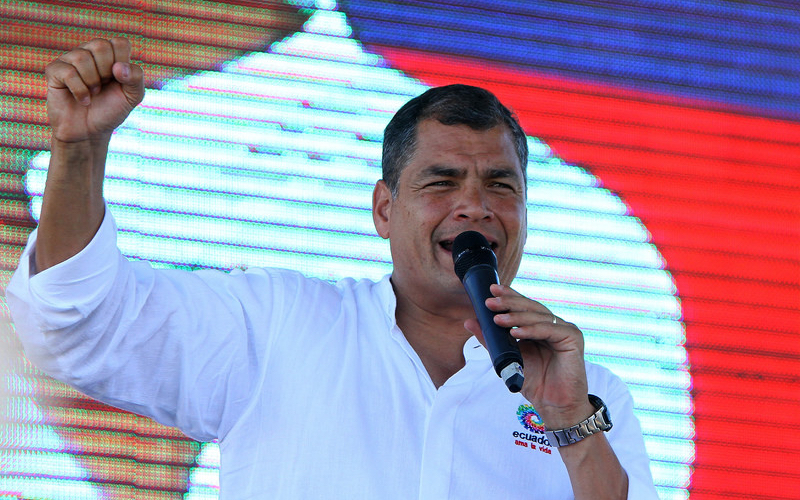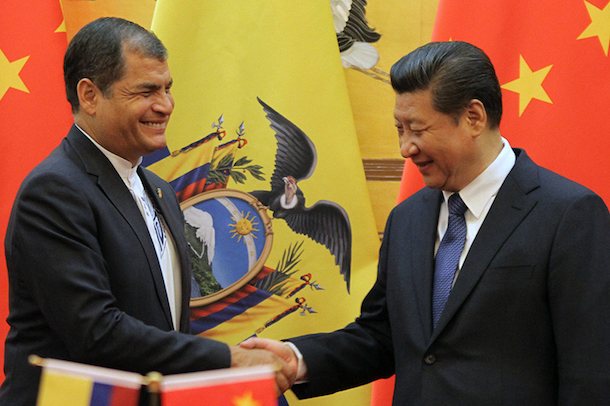
The China Mirage in Latin America
With the ratification of the Monroe Doctrine in 1823, the United States firmly asserted its hegemony over the Western Hemisphere as to dissuade other powers from meddling in the region. There has been so much discussion on U.S. policies in Latin America, but several factors have contributed to China’s presence in Latin America. First, even though Latin America is not as strategically important to China as East Asia and South Asia, its outreach has resulted in increased social and economic cooperation. In the words of Former Chinese leader Deng Xiaoping; “lie low and bide your time.”
Second, the balance of power has changed in the region, where U.S. influence is dwindling and China has proven to be a reliable economic partner for developing countries. Also, the United States’ close engagement with its allies in Asia has driven China to counterbalance its relationship with Latin America.
Third, China has commercial and geopolitical interests in Latin America. China has pushed forward to diversifying its imports and is seeking new raw materials. In 2014, “Bilateral trade between China and Latin America stood at $263 billion.” Lastly, China adheres to the policy of multilateralism and it tries to not be a bully to its trading partners. China’s ties to the global south (mostly developing countries) have led to a better understanding of the demands and global interests of both sides. In addition, China’s policy of solidarity has been a footprint for expanding its desires in Latin America, and its bonhomie has altered the U.S. foreign policy in the region.
President Xi’s Tour De Latin America
On November 17, Chinese President Xi Jinping arrived in Quito, Ecuador to begin his week-long Latin America. Before departing to Santiago, Chile, President Xi participated in the Asian-Pacific Economic Cooperation (APEC) Summit in Lima, Peru. The main purpose of Xi’s trip was to promote social and economic development in Latin America.
China has made significant steps in reviving Latin America’s most dormant economies, “From Brazilian iron ore to Venezuelan oil, China’s hunger for natural resources drove up global commodity prices from 2003 to 2013, fueling a natural-resource boom that resulted in one of Latin America’s fastest periods of growth in decades. By 2014, the region’s trade with China was 22 times greater than it had been in 2000, dwarfing the growth of its commerce with any other country.”
APEC has played an active role for China to increase economic cooperation and promote trade. The People’s Republic had reached many achievements during the APEC Summit; “First, the meeting will complete the collective strategic study for the Asia-Pacific free trade area as scheduled, and propose policies and recommendations on further realizing the Asia-Pacific free trade area. Second, the meeting will continue to deeply implement relevant outcomes of the Beijing meeting to propel cooperation in connectivity and global value chain. Third, the meeting will support inclusive growth in the Asia-Pacific region and push for new cooperation achievements in the service industry, small and medium-sized enterprises and other areas.”
As China’s presence in Latin America increases, President Xi’s Latin America tour first stopped in Quito, Ecuador where he met with Ecuadorian president Rafael Correa. On November 17, President Xi and President Correa agreed to a new economic Free Trade Agreement (FTA) to increase production and investment on improving energy, infrastructure, and agriculture. Also, both countries are taking steps to, “increase exchanges in science, technology, communication, culture, sports and education.” After the earthquake, China was one of the first nations to supply humanitarian aid to Ecuadorian victims. China has maintained its promise on, “rebuilding, and continue to provide support in housing, medical treatment, human resources and disaster prevention and reduction.” China has become Ecuador’s third largest trading partner and the foreign investment continues to increase. Fernando Casado, a researcher at the Institute of Higher National Studies calls the strategic partnership a “part of the view that bilateral relations are continuously improving and, without a doubt, highlights the importance and impact that Chinese cooperation has on Ecuador.”

In Lima, the meeting between President Xi and his Peruvian counterpart Pedro Pablo Kuczynski witnessed the signing of an extension of the China-Peru free trade agreement that was signed in 2009, which is “conducive to promoting bilateral trade and investment liberalization and facilitation, optimizing the benefits from the FTA and injecting new vigor into bilateral trade and economic relations.”
This is significant because currently, China is Peru’s largest trading partner, largest export market, and one of China’s largest trading partners in Latin America. China and Peru have forged diplomatic ties since 1971 and they still have a comprehensive strategic partnership. At present, over 150 Chinese firms are conducting business in Peru and investment has fundamentally increased over $10 billion. President Xi discussed economic growth in his speech to the Peruvian Congress and he called Peru “a rapidly developing society.” President Xi’s visit to Peru has deepened the ties between China and Peru which will promote better dialogue and emphasis on the industrial sector as well as on education, technology, and culture. President Kuczynski has welcomed a new relationship with Beijing and he has also welcomed Chinese investments.
Xi Jinping’s final leg of his Latin America tour stopped in Santiago, Chile. China has become Chile’s largest trading partner since 2005, and the two countries have raised some hope for taking their bilateral relations to the next level. Historically, Chile was one of the first Latin American countries to create diplomatic relations with the People’s Republic of China when it was founded in the early 1950’s. In addition, Chile, “was also the first Latin American country that signed a free trade agreement (FTA) with China.” The two sides have signed multiple agreements related to increasing the number of imports and exports between the two countries. China and Chile have agreed to upgrade their free trade agreement, increase trade and investment, as well as financial governance.
In President Xi’s state visit speech, he stated that China will continue to invest in infrastructure, mining, agriculture, and communications in Chile. China and Chile are also family members of the Asia-Pacific Region. As a result of the APEC meetings, China has established itself as a reliable world trade partner that can contribute to the world economy and support the contributions Latin America can make as well. During the bilateral meetings, President Xi and President Bachelet signed twelve agreements ranging from infrastructure to clean energy. China and Chile have also issued a joint statement for strategic cooperation. Both sides have simplified their own visa policies to enhance people-to-people exchanges. And lastly, the two countries will continue to enhance their cooperation and deepen their economic relations.
The New Normal
The ongoing relationship between China and Latin America will continue to increase and following the APEC Summit, President Xi has created a ‘path of confidence’ for China’s future relations with the region. The Trans-Pacific Partnership (TPP), which was vigorously promoted by the Obama Administration, is now dead and the newly elected President Donald Trump plans to put the final nail in the coffin. China now has been presented with a great opportunity to expand its influence on the trade horizon in the Pacific.
We are now at an inflection point in the Asia-Pacific and there has been a shift in the strategic paradigm in the region. Traditionally, the United States has played a very important role in advancing the liberal, free-market agenda in the Asia-Pacific region, but as symbolized by the election of Donald Trump, many Americans are clamoring for protectionist policies to decrease the influence of foreign countries on the U.S economy. With the TPP dead, there is a huge opportunity for China. During the APEC Summit, President Xi laid out the agenda for the Latin American countries saying ‘come join us and let’s move forward.’
The question is about how China’s vision will get realized by the Latin American community. China’s economic goals need to be flexed out if it has any chance of succeeding. Moreover, there are some obstacles China faces in Latin America. Some of these impediments include geographic distance, language barriers, respect for indigenous peoples, and especially the protection of the environment. China’s ‘confidence path’ in Latin America is not a straight line, but it is a massive opportunity for China to increase its economic prowess. The Free Trade Agreement of the Asia-Pacific (FTAAP) is obviously a part of the agenda for which, not much action has been taken, but now without the TPP, FTAAP is a way forward for both sides.
The ‘one belt, one road initiative’ has been the epicenter of international development for China. In Lima, President Xi has welcomed Latin America to join this ‘one belt, one road initiative’ which is a large expansion of ambition because it is not only a continuous number of landmasses joining China, but it is now a global initiative. The relationships between China, the United States, and Latin America form a strategic triangle. There is nothing wrong with Latin American countries having a balance of relations with the United States, but with China’s economic rise, more countries want to continue economic development with China and other Asia-Pacific countries as well. Latin American countries now have more links in the diplomatic arena to create common interests and reach common ground on social and economic issues, as well as promoting the idea of a state-market-society.
Both China and the United States have specific social and economic interests in Latin America, but the region itself has its own ambitions and options on how to carry out its own diplomacy.
Recommendations
The China-Latin America relationship would be a win-win one if both sides can improve on the following areas. First, national governments must continue to stabilize institutions such as the Inter-Development Bank and the Economic Commission for Latin America and the Caribbean (ECLAC). In addition, both sides must find concrete solutions to address infrastructure projects, trade, foreign direct investment, and people-to-people dialogue. Also, China and Latin America are dependent on each other. China would be interested in investing in Latin American oil and energy sectors, while Latin America could invest in innovative technology and foreign direct investment.
After this year’s APEC Summit and President Xi’s visit to Latin America, China and Latin America now have a better understanding of each other and it is time for their relationship to move forward on opening a new chapter. Latin America should continue to establish bilateral relations with China on socioeconomic issues and focus on development in specific sectors and policy mechanisms. If both sides can agree to these examples, the China-Latin America bond will only get stronger and not weaker.

